
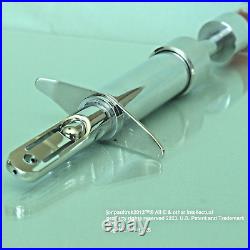
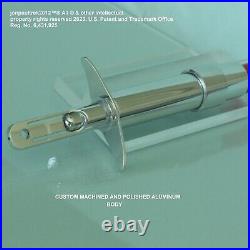
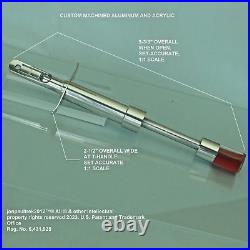
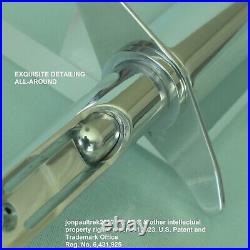
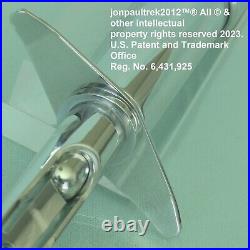
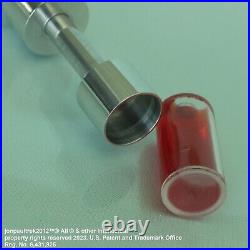
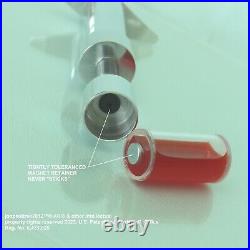

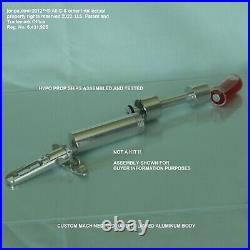
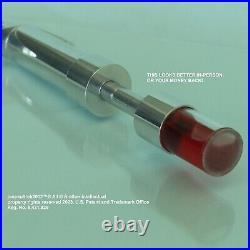
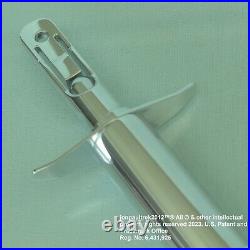

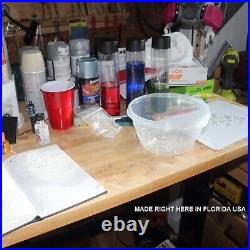
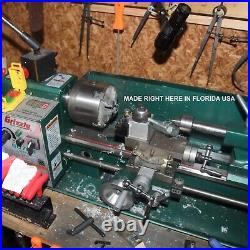

Star Trek TOS, Dr. Machined Aircraft Grade Aluminum & Acrylic. Hypo and other parts are machined from aircraft-grade aluminum. Set accurate size, materials, and details, just like on-set in the 1960’s. Overall dimensions are in the photos of this listing. Details are exquisite and the finish is an unmatched mirror polish. Prop Hypo is assembled with threads, and not glued, in case the user wants to field strip it. Vials are leak-tested, however, contact me within 7 days of receipt if you think the QC test failed and you have a leak. The “0” ring design provides a nice plunge feeling, and yes a little “Hiss” out of the end of this prop. Do not expect a Hiss like the TV show dubbed-in sound effect. That is just never gonna happen. Removable Vile is secured with a closely toleranced fit and a recently revised stronger magnet (we went to a stronger magnet to respond to customer feedback). Unlike many similar replicas, on my Prop you do not have to be. To remove the vial (LOL). History Of The Hypospray. Is a medical device from the science fiction television series. It’s similar to a jet-injector, a real medical device, with the main difference being that the fictional medical device doesn’t penetrate the skin. The concept of the hypospray was developed when producers of the original. Series discovered that NBC’s broadcast standards and practices prohibited the use of hypodermic-syringes to inject medications; the needleless hypospray sidestepped this issue. The prop used in the original series appeared to be a modified fuel injector for a large automotive diesel engine, similar to the engines from which jet injectors were derived. Universe, the Hypospray was developed by the mid-22nd century, as it is featured in. McCoy in Star Trek: The Original Series is seen using it often with mostly a Red-Vial (longer red vial in “Miri” episode), with Blue (Methuselah) and Warm yellow vial’s, making brief appearances as in “Whom Gods Destroy”. The fictional device applies medication by spraying it onto the skin, and can be used directly or through clothing. The real-life jet injector is usually applied at the top of the arm, but the fictional hypospray is sometimes applied at the neck. It administers medication subcutaneously and intramuscularly. The fictional Hypospray is extremely versatile, as the medicine vials can be quickly swapped out from the bottom of the Hypospray. As the Hypospray is bloodless, it is not contaminated by use. This allows it to be used on many people until the supply of medicine runs out. Whitfield SE, Roddenberry G (1991) [1969]. The Making of Star Trek. American Journal of Health-System Pharmacy. Doi:10.1093/ajhp/8.3.182. TREKNOSIS: Is There In Truth, No Hypospray? Retrieved 8 October 2022. Okuda, Michael; Okuda, Denise (2016). Star Trek encyclopedia: a reference guide to the future. Revised and expanded ed. As Researched By Episode Views and, on Memory Alpha. Hypospray TOS Episodes included (among many): “Amok Time” Red vial, “Where No Man Has Gone Before” Red vial, also seen in “Naked Time” Red vial, “Whom Gods Destroy” Red vial and. “Plato’s Stepchildren” featuring; Red, Yellow, and Blue vials. The “Wolf In The Fold” shows the rarely-seen in a Blue vial of fluid. And finally, the “Mirror Mirror” episode featured the rarely-seen vial of Green fluid. The 23rd-century Federation hypospray resembled the intravenous needles of previous centuries, while the 24th-century version of the device was more compact, employing an angled head and rounded tip to transfer the drug more easily. Controls at the injection head set the dosage to be injected. SEDATIVES (Red Vials, Blue Vials). Patant and Trade Mark Information, Toy Patent. Some Star Trek Prop History For Inquiring Minds. Most of these Prop Makers and Technicians have passed-on. Below are old-timer accounts of convention conversations before conventions were really a fad. (all these are therefore 2nd hand stories). The persons quoted worked for; Desilu ®, NBC ®, Paramount ® & Gene R. Bob Stone was Star Trek’s machinist and made all the metal prop parts for all three seasons of the show. Parts were made to order for each episode as in those times (the 1960’s) as machining was done by hand and there was no advantage to making short runs (and no studio funding either). Each episode had a specific budget. According to Bob there was no magic drum of Phaser Nozzles and every job was a mad-dash to meet the filming deadlines. Because parts were made only to order, parts varied quite a bit. These variations can be seen in all the surviving examples of TOS hand props from Phaser to Communicators and Tricorders. Sometimes it was not that a new design was needed but rather that when one Wings it from a sketch, in a hurry using what is on-hand, you get an unintended-new-version of something (in the 1960’s the TV audience never could see that). Robert Archer and Bob Stone worked closely together so when the show was canceled suddenly in season three, Robert Archer ended up with a nice collection of hand props. Richard Heimer made the molds for hand props. He also did all the casting and forming. This included; Vacuum form bucks, Fiberglass molds and urethane molds. Again, according to him most work is done in the normal Hollywood maddening rush. He shared with his convention friends that there were many molds made from molds when the production schedule demanded this. He also shared that when the show ended he rescued the molds from being discarded by putting them in his garage. 1919 was the director of special effects for the show. He handled and repaired many of the props on-set. When the show was canceled in season three he rescued many hand props and even some models from the scrap heap. Dick Ruben, Prop & Art Assistant on the show, got his Set-Used Klingon disruptor from James. Ruggs held on to his rather large Star Trek collection for many years. It is widely known that Greg Jein got his Holy-Grail Hero Phaser from James. In closing a nod to Mr. Ruck, a prop technician, who reported that he repaired some hand props hundreds of times as they were often damaged during filming. He had also shared that the fiberglass Mid-Grade’s, and some other props often used basswood strips between the seams to establish uniform dimensions. Watch some YouTube Star Trek TOS bloopers to see what he was talking about when it comes to repairs and hand props flying apart.
